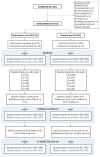Stimulation of the tibial nerve-a randomised trial for urinary problems associated with Parkinson's-the STARTUP trial
- PMID: 35704616
- PMCID: PMC9200143
- DOI: 10.1093/ageing/afac114
Stimulation of the tibial nerve-a randomised trial for urinary problems associated with Parkinson's-the STARTUP trial
Abstract
Background: non-motor symptoms such as bladder dysfunction are common (80%) in people with Parkinson's increasing the risk for falls with a negative impact on health-related costs and quality of life.We undertook STARTUP to evaluate the clinical and cost-effectiveness of using an adhesive electrode to stimulate the transcutaneous tibial nerve stimulation (TTNS) to treat bladder dysfunction in people with Parkinson's disease (PD).Study design, materials and methods: STARTUP was a parallel two-arm, multi-centre, pragmatic, double-blind, randomised controlled trial. Each participant attended one clinic visit to complete consent, be randomised using a computer-generated system and to be shown how to use the device.The trial had two co-primary outcome measures: International Consultation on Incontinence Questionnaire-Urinary Incontinence Short Form and the International Prostate Symptom Score (IPSS). These were completed at baseline, 6 and 12 weeks. A bladder frequency chart and resource questionnaire were also completed.
Results: two hundred forty two participants were randomised. About 59% of participants were male, the mean age was 69 years and mean time since diagnosis was 6 years. Questionnaire return rate was between 79 and 90%.There was a statistically significantly lower score in the active group at 6 weeks in the IPSS questionnaire (mean difference (Standard deviation, SD) 12.5 (6.5) vs 10.9 (5.5), effect size -1.49, 95% CI -2.72, -0.25). There was no statistically significant change in any other outcome.
Conclusion: TTNS was demonstrated to be safe with a high level of compliance. There was a significant change in one of the co-primary outcome measures at the end of the treatment period (i.e. 6 weeks), which could indicate a benefit. Further fully powered RCTs are required to determine effective treatments.
Keywords: Parkinson’s; bladder dysfunction; neurology; neuromodulation; older people.
© The Author(s) 2022. Published by Oxford University Press on behalf of the British Geriatrics Society. All rights reserved. For permissions, please email: journals.permissions@oup.com.
Comment in
-
Geriatrics.J Urol. 2023 Aug;210(2):362-365. doi: 10.1097/JU.0000000000003524. Epub 2023 May 9. J Urol. 2023. PMID: 37157786 No abstract available.
Similar articles
-
Stimulation of the tibial nerve: a protocol for a multicentred randomised controlled trial for urinary problems associated with Parkinson's disease-STARTUP.BMJ Open. 2020 Feb 17;10(2):e034887. doi: 10.1136/bmjopen-2019-034887. BMJ Open. 2020. PMID: 32071190 Free PMC article.
-
Stimulation of the Tibial nerve Repetitively to Improve Incontinence in Parkinson's Electronically (STRIPE trial): a randomised control trial of tibial nerve stimulation for bladder symptoms in Parkinson's disease using a self-contained wearable device.Trials. 2022 Oct 28;23(1):912. doi: 10.1186/s13063-022-06827-3. Trials. 2022. PMID: 36307874 Free PMC article. Clinical Trial.
-
Transcutaneous tibial nerve stimulation in the treatment of lower urinary tract symptoms and its impact on health-related quality of life in patients with Parkinson disease: a randomized controlled trial.J Wound Ostomy Continence Nurs. 2015 Jan-Feb;42(1):94-9. doi: 10.1097/WON.0000000000000078. J Wound Ostomy Continence Nurs. 2015. PMID: 25549314 Clinical Trial.
-
The effectiveness of transcutaneous tibial nerve stimulation (TTNS) for adults with overactive bladder syndrome: A systematic review.Neurourol Urodyn. 2018 Feb;37(2):528-541. doi: 10.1002/nau.23351. Epub 2017 Jul 21. Neurourol Urodyn. 2018. PMID: 28731583
-
Treatment for overactive bladder: A meta-analysis of transcutaneous tibial nerve stimulation versus percutaneous tibial nerve stimulation.Medicine (Baltimore). 2021 May 21;100(20):e25941. doi: 10.1097/MD.0000000000025941. Medicine (Baltimore). 2021. PMID: 34011072 Free PMC article.
Cited by
-
Transcutaneous tibial nerve stimulation in patients with multiple sclerosis and overactive bladder: a real-life clinical and urodynamic assessment.World J Urol. 2024 Mar 13;42(1):136. doi: 10.1007/s00345-024-04836-2. World J Urol. 2024. PMID: 38478090
-
Evaluation of transcutaneous electrical tibial nerve stimulation in lower urinary tract dysfunction secondary to a parkinsonian syndrome: Uroparktens-a multicenter randomized placebo-controlled study.World J Urol. 2025 Apr 7;43(1):214. doi: 10.1007/s00345-025-05597-2. World J Urol. 2025. PMID: 40192925 Clinical Trial.
-
Effectiveness of electrical stimulation with conservative treatment for lower urinary tract symptoms in Parkinson's disease: A three-armed randomized controlled trial protocol.Contemp Clin Trials Commun. 2025 Mar 29;45:101480. doi: 10.1016/j.conctc.2025.101480. eCollection 2025 Jun. Contemp Clin Trials Commun. 2025. PMID: 40241934 Free PMC article.
-
European Academy of Neurology (EAN)/European Federation of Autonomic Societies (EFAS)/International Neuro-Urology Society (INUS) Guidelines for Practising Neurologists on the Assessment and Treatment of Neurogenic Urinary and Sexual Symptoms (NEUROGED Guidelines).Eur J Neurol. 2025 Apr;32(4):e70119. doi: 10.1111/ene.70119. Eur J Neurol. 2025. PMID: 40208234 Free PMC article.
-
The importance of electrical parameters on transcutaneous tibial nerve stimulation for overactive bladder syndrome: a systematic review and meta-analysis.Age Ageing. 2025 Jul 1;54(7):afaf203. doi: 10.1093/ageing/afaf203. Age Ageing. 2025. PMID: 40711757 Free PMC article.
References
-
- McDonald C, Winge K, Burn DJ. Lower urinary tract symptoms in Parkinson's disease: prevalence, aetiology and management. Parkinsonism Relat Disord 2017; 35: 8–16. - PubMed
-
- NICE . Urinary incontinence and pelvic organ prolapse in women: management. NICE Guideline [NG123], 2019. - PubMed
-
- Giannantoni A, Rossi A, Mearini E, del Zingaro M, Porena M, Berardelli A. Botulinum toxin a for overactive bladder and detrusor muscle overactivity in patients with Parkinson’s disease and multiple system atrophy. J Urol 2009; 182: 1453–7. - PubMed
Publication types
MeSH terms
LinkOut - more resources
Full Text Sources
Medical


